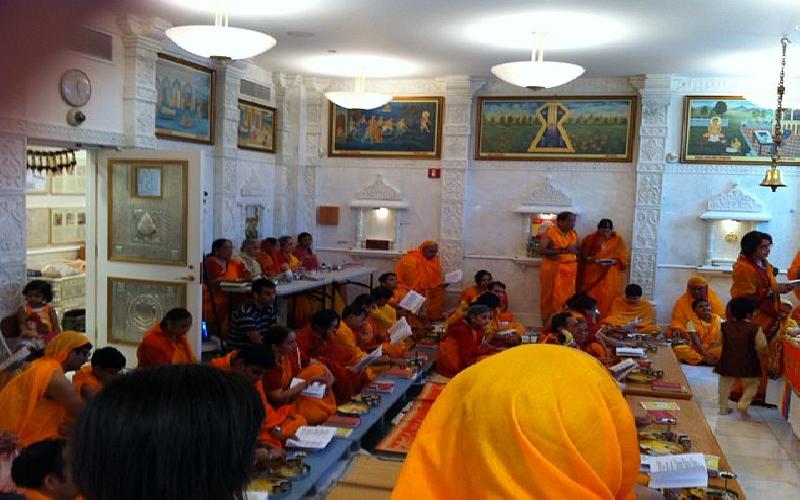The Ancient Jain Festival that celebrates the Act and Spirit of Forgiveness is still Popul


The philosophy of Buddhism and Jainism prospered in ancient India, reaching their zenith in the centuries immediately preceding Christianity. While there is not enough evidence to suggest their impact on Christianity, there are several striking similarities. One of them, at least, is the celebration of Forgiveness in the Jain Festival of Paryushana....
The Jain Festival of Paryushana which falls in the month of June marks the beginning of rainy reason. The festivities associated with it are another example how religion and festivities were closely interwoven in the life of ancient Indian people. Religious philosophies were not just matter of faith, they were part and parcel of how people lived their life.
PARYUSHANA is one of the two major festivals of Jains, the other being DIWALI which is the day on which last Jain Tirthankar attained MOKSHA or liberation.
Paryushana festival is held on the PANCHAMI or the fifth day of the disappearing moon cycle or SHUKLA half in the month of BHADRAPAKSHA in the Jain lunar calendar. It marks the beginning of the rainy season called CHATURMASA or 'four months' of rains, during which the monks stay at one place. The minimum duration of this stay is actually 70 days.
Traditionally, the longer stay of monks at a place also means an opportunity for the followers of the Jainism philosophy to renew their faith and understanding, by indulging in various religious activities under their guidance. It is thus a time for philosophical discussions and VRATAs, acts of self control undertaken with the purpose of developing self-discipline and commitment, and purifying one's soul.
The original term for Paryushana is PAJJO-SAVANA, in PRAKRIT language that was the language of the masses in North India during the time of last Jain Tirthankar, Shri Vardhman Mahavir.
In Digambars, the festival begins with Paryushana and lasts for ten days.
During this period, TATVARTHA SUTRA of UMASVATI, a religious scripture is recited. The SUGANDHA DASHMI VRATA is held on the tenth day. The Digambars celebrate the following fourteenth day of the shukla (disappearing moon) called ANANTA CHATURDASHI. On this day, processions are held in many towns leading to the main Jain temple.
In Swetambars, the festivities and Vrata last for eight days, ending on the Bhadra Shukla Panchmi, the last day is called SAMVATSARI PRATIKRAMAN, or SAMVATSARI in short, literally meaning 'renewing meditation.'
For both the Digambar and Swetambar sects, the renewed meditation must be undertaken at least once every year, on the day of Samvatsari Pratikraman. It has many facets of self purification like SAMAYIKA, or staying in equanimity, prayers, Vratas, reflections , KAYOTSARGA or detachment from the body and PRATYAKHYAN or making resolutions for the next year.
The ten day Vrata coinciding with Paryushana emphasizes the ten components of Dharma. These include NOBLE KSHAMA or forbearance, MARDAVA or gentleness, ARJAVA or uprightness, SHAUCHA or purity, SATYA or truthfulness, SANYAM or self-restraint, TAPA or austerity, TYAGA or renunciation of wealth and attachments, AKINCHAANYA or lack of possession and BRAHMACHARYA or chastity.
During the festival the followers seek forgiveness by way of MICCHAMI DUKKADAM, meaning, "if I have caused you offence in any way, knowingly or unknowingly, in thought word or deed, then I seek your forgiveness". Paryushana and related activities are one of the main religious festivities in Jainism, and a reflection of its philosophical ethos and faith.
This legend is celebrated on Janmashtami by people keeping fast, singing devotional songs of love for Krishna, and keeping a vigil into the night.[13] After Krishna's midnight hour birth, statues of baby Krishna are washed and clothed, then placed in a cradle. The devotees then break their fast, by sharing food and sweets.
Ram Navami is an important festival in India celebrated as the birthday of Ram, the King of Ayodhya, who is considered one of the greatest ideals by Indian because of his selfless devotion to duty towards his family as well as the people, and his great courage and leadership qualities. His story, known as Ramayan, is one of greatest epics of ancient times.
.Shiva means benevolent, and represents the form of God that brings about creative destruction of old so as to make way for the new. Maha Shivratri has its origin in the mythological story of Shiva indulging in Tandava after her wife, Sati gave up her life on being insulted by her father looked down on Shiva.